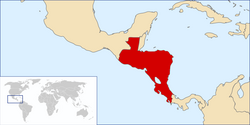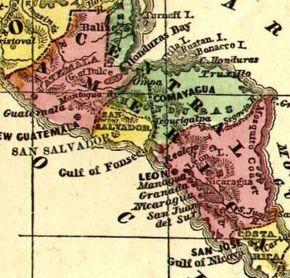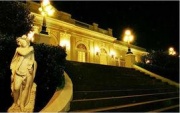Central America
From Roach Busters
| Provincias Unidas del Centro de América United Provinces of the Center of America | |
| | |
 | 
|
| Flag | Coat of arms |
| | |
| Motto "Dios, Unión y Libertad" (Spanish) "God, Union and Liberty" | |
| | |
| Anthem La Granadera | |
| | |

| |
| | |
| Capital Largest city | San Salvador 13°40′N, 89°10′W Guatemala City |
| | |
| Official languages | Spanish |
| | |
| Demonym | Central American |
| | |
| Government - President - Vice-President | Federal republic Anastasio Somoza Portocarrero José Rizo Castellón |
| | |
| State religion | Roman Catholic Church |
| | |
| Establishment - Independence from Spain - Independence from Mexico - Constitution adopted | September 15, 1821 July 1, 1823 December 17, 1823 |
| | |
| Area - Total - Water (%) | 423,016 km² 163,362 sq mi 2.52 |
| | |
| Population - 2008 estimate - Density | 37,689,696 89/km² 231/sq mi |
| | |
| GDP (PPP) - Total - Per capita | 2007 estimate $547 billion $14,500 |
| | |
| GDP (nominal) - Total - Per capita | 2007 estimate $490 billion $13,000 |
| | |
| Gini (2006) | |
| | |
| HDI (2005) | |
| | |
| Currency | Central American real (CAR)
|
| | |
| Time zone - Summer (DST) | CST (UTC -6) not observed (UTC -6) |
| | |
| Internet TLD | .up |
| | |
| Calling code | +500 |
The United Provinces of the Center of America (Spanish: Provincias Unidas del Centro de América), commonly called Central America (Spanish: Centroamérica or América Central), is an upper-middle income nation in Central America. Bordering Mexico to the north, Belize to the northeast, and the Confederate States of Latin America to the south, it is one of the oldest republics in the Western Hemisphere. Formed by the union of Costa Rica, El Salvador, Guatemala, Honduras, and Nicaragua, the nation will celebrate its bicentennial in 2023.
A geographically and culturally diverse nation abundant in resources, flora, and fauna, the United Provinces of Central America enjoys some of the greatest biodiversity in the world - bringing it to the attention of not only scientists, but also tourists, who flock to the country by the millions every year, earning the country much revenue. Also of note is the country's extensive, sometimes tumultuous, geographic activity; volcanic eruptions and earthquakes occur from time to time, with varying severity, from minor tremors to cataclysmic disasters taking thousands of lives (notable examples being the 1931 and 1972 Managua earthquakes).
An intensely socially conservative nation, it is the only country in the world where abortion is illegal without exception - even when the mother's life is in danger. Divorce and homosexuality remain social taboos, and the status of women leaves much to be desired. Though religious freedom is protected by law and the majority of Central Americans are tolerant of other faiths, the Roman Catholic Church remains the official religion, and, as can be surmised, wields a considerable amount of influence.
Though much social, political, and economic progress has been made in the past few decades, especially since the early 1980s, corruption remains a cause of concern and income and land distribution is among the most inequal in the world.
Contents |
History
Pre-colonial history
In pre-Columbian times, most of modern Central America was part of the Mesoamerican civilization. The Native American societies of Mesoamerica occupied the land ranging from central Mexico in the north to Costa Rica in the south. Most notable among these were the Maya, who had built numerous cities throughout the region, and the Aztecs, who created a vast empire. The pre-Columbian cultures of Panama traded with both Mesoamerica and South America, and can be considered transitional between those two cultural areas.
Colonization
Following Christopher Columbus's discovery of the Americas for Spain, the Spanish sent numerous expeditions to the region, and they began their conquest of Maya lands in the 1520s. In 1540, Spain established the Captaincy General of Guatemala, which extended from southern Mexico to Costa Rica, and thus encompassed most of what is currently known as Central America, with the exception of British Honduras (present-day Belize). This lasted nearly three centuries, until a rebellion (which followed closely on the heels of the Mexican War of Independence) in 1821.
Independence
In 1821 a congress of Central American criollos declared their independence from Spain, effective on 15 September of that year. That date is still marked as the independence day by most Central American nations. The Spanish Captain General, Gabino Gaínza, sympathized with the rebels and it was decided that he should stay on as interim leader until a new government could be formed. Independence was short-lived, for the conservative leaders in Guatemala welcomed annexation by the Mexican Empire of Agustín de Iturbide on 5 January 1822. Central American liberals objected to this, but an army from Mexico under General Vicente Filisola occupied Guatemala City and quelled dissent.
When Mexico became a republic the following year, it acknowledged Central America's right to determine its own destiny. On 1 July 1823, the congress of Central America declared absolute independence from Spain, Mexico, and any other foreign nation, and a republican system of government was established.
Early republic
In 1823 the nation of Central America was formed. It was intended to be a federal republic modeled after the United States of America. The Central American nation consisted of the states of Guatemala, El Salvador, Honduras, Nicaragua, and Costa Rica.
Central American liberals had high hopes for the United Provinces, which they believed would evolve into a modern, democratic nation, enriched by trade crossing through it between the Atlantic and the Pacific oceans. These aspirations are reflected in the emblems of the federal republic: The flag shows a white band between two blue stripes, representing the land between two oceans. The coat of arms shows five mountains (one for each state) between two oceans, surmounted by a Phrygian cap, the emblem of the French Revolution.
In the late 1830s, the nation nearly dissolved as a result of civil war, which directly resulted from Honduras's attempt to secede on November 5, 1838. A brief but economically disastrous war followed, which ended in 1840 with Honduras's re-integration into the Union.
Economy
to be added
Politics
Central America is a federal republic with a level of de-centralization surpassed only by Switzerland. Like Switzerland, it is highly democratic, and the Constitution guarantees a great deal of civil liberties. Unlike Switzerland, the Central American government remains dominated by a parochial elite, and corruption and patronage remain widespread. While the government generally honors the Constitution's commitments to personal freedoms, politics remains a game played with loaded dice, in which, regardless of the electoral outcome, the players remain largely the same. Even so, Central Americans are a public-spirited, civic-minded, highly politically active people, and elections are eagerly anticipated occasions and public debate is lively. The country's fairly high living standards, and the large degree of freedom people enjoy in their daily lives, causes most Central Americans to overlook the many inherent flaws in their political system.
Federal government
Legislature
The legislative branch of Central America is the unicameral Federal Congress, whose members are popularly elected on a numerical basis, renewable by halves each year. Its primary function is to adopt federal laws (i.e, draft bills). The Federal Congress convenes in the National Palace (Palacio Nacional).
The Senate
The Central American Senate differs from most other senates in that it is not a legislative body. It takes no initiative in the formulation of laws, but instead simply approves or denies bills. It also functions as an advisory body to the executive branch and serves as a "moderator power." The membership of the Senate is popularly elected and renewable by thirds each year.
Executive
The head of state in Central America is the President, who presides over the executive branch. Unlike the President of the United States, who is elected by the Electoral College, the President of Central America is popularly elected; like the President of the U.S., the Central American President's term is four years long. He is eligible for re-election, but his terms must be consecutive. For example, if the incumbent President loses the next election, he may not run again. A President is limited to a maximum of two terms. The President and the Vice-President are elected on the same ticket. The President has very limited powers and cannot veto bills. His main duty is to enforce public order and direct the military of Central America. He also conducts foreign policy in consultation with the Senate, which also proposes lists for the appointment of federal officials. Finally, the President presides over the Senate, but cannot vote except in the event of a tie. The Vice-President mainly serves as a "spare wheel," for the President; in the event that the President dies, resigns, becomes incapacitated, is removed from office, or is otherwise unable to fulfill his duties, the Vice-President does so in his stead. The President's official residence is the Casa Presidencial (English: "Presidential House") in San Salvador. His annual salary is 175,000 reales.
Judiciary
The Supreme Court of Justice, the judiciary, differs from most other judicial bodies around the world in that its membership is popularly elected (renewable by thirds every two years). The Supreme Court of Justice functions as a court of last resort, hears cases against the President and other senior officials, and establishes juries and appellate courts. All citizens, without distinction, are subject to the same order of proceedings and trials; in other words, there are no special courts for the military and ecclesiastical jurisdictions.
State governments
The composition of state governments is largely similar to that of the federal government. Each state has a unicameral legislative body (known as Congress), a Representative Council (which sanctions or vetoes laws passed by Congress; essentially, it forms the same function as the Senate does at the federal level), an executive (known as the Chief; there is also a Second Chief, much like the Vice-President), and a judiciary (like its federal counterpart, known as the Supreme Court of Justice). Each of these is popularly elected in the same manner as their counterparts at the federal level, and fulfill the same duties. The Constitution stipulates that whatever powers are not explicitly granted to the federal government, nor denied by it to the states, are reserved for the state and local governments.
List of States
Political parties
For most of its history, the country's politics have revolved around two political parties, the Liberal Party (Partido Liberal) and the Conservative Party (Partido Conservador). Both parties are more groupings of members of the Federal Congress than ideologically based movements dependent on distinct electorates. No particular political philosophy distinguishes one group from another; however, while ideological differences between the two parties are rather negligible, the Liberals vaguely represent labor and social programs and the interests of artisans and workers, while the Conservatives vaguely represent certain business sectors and are more closely affiliated with the Roman Catholic Church.
In reality, members of both parties come from the same social groups: Plantation owners, bureaucrats, professionals, and businessmen. Though the differences between the parties are trivial, factional and personal rivalries among the two parties (and even within them) are intense, and make cooperation difficult. Both parties also tend to be dominated by wealthy politically-connected families: The Liberals by the Somoza family, and the Conservatives by the Figueres family. Patronage is rife within both parties, and contacts and favor rather than ability determine success in party circles.
While third parties are perfectly legal and do exist, the domination of most television stations, newspapers, and other media by the Somoza and Figueres families, coupled with draconian ballot access laws, effectively makes it impossible for other parties to come to power, except at the local and, very rarely, the state level.
More importantly, a constitutional provision, implemented in the 1970s, allows the Liberals and Conservatives to monopolize power. Following widespread riots after the disputed 1968 presidential election, a behind-the-scenes power-sharing compromise was reached. Whichever party won congressional elections would receive 60% of the seats, and the other party, regardless of how much lower its share of the vote was, would receive the remaining 40%. This "compromise" remains a contentious issue in Central America, and many are calling for its repeal, though it remains to be seen whether or not this will happen.
The Constitution proscribes the formation of Marxist political parties or organizations.




